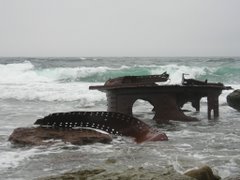 When we rolled into Forteau, my two sons, Drew and David, and I weren't long hearing about the Atlantic Salmon fishing action so far that summer.
When we rolled into Forteau, my two sons, Drew and David, and I weren't long hearing about the Atlantic Salmon fishing action so far that summer.
"Gavin's been 'avin' a good season, Skipper!" said Doug. "'e's got a 'oney 'ole we calls 'Gavin's Pocket'. By Jeezus, 'e's 'auled a 'few outta dat, da year, eh Mona?"
"'e's not da only one - I say ye got yer share, if ya wants to know da truth" cried Mona.
We geared up and headed for the river, with Gavin as our guide. At one pool, we saw fish, but got ne'er a raise. A good walk downstream, Gavin showed us his 'pocket'.
"I was fishin' in da middle, dere, " he said. "I always gives dat a flick on me way d-d-d-down by. Dis one day, it was blowin' a gale. I'se just after tyin' on a bug when da wind takes it clean outta me 'and. She lands right in dat pocket dere, behind dat rock, and kinda d-d-d-dances across da surface. Outta da corner of me eye, I seen dis fish make a d-d-d-dodge fer it - fired back and B-B-B-B-Bango! I 'ad 'im!"
Gavin had indeed found a 'honey hole' in a place most people would walk past without wetting a line. Close to shore, it was hard to believe that a salmon would lie there, but Gavin's Pocket produced fish for us all week. There are lessons in this:
- There is no substitute for a good local guide, especially when you have a limited amount of time to fish. It takes much of the guesswork out of the equation. A good guide will put you on fish - it will be your job to catch them.
- Don't ignore shallow water, or water very close to shore - big fish will rest there if there is some cover. That cover could be a corrugated surface caused by wind, or current. It could be the cover of darkness, or an overhanging limb.
- For an added bonus, salmon lying in shallow water can be more likely to take a fly, particularly a dry fly, than if they were lying at the bottom of a deep hole.
- Random Phrump
Photo by: Random Phrump











